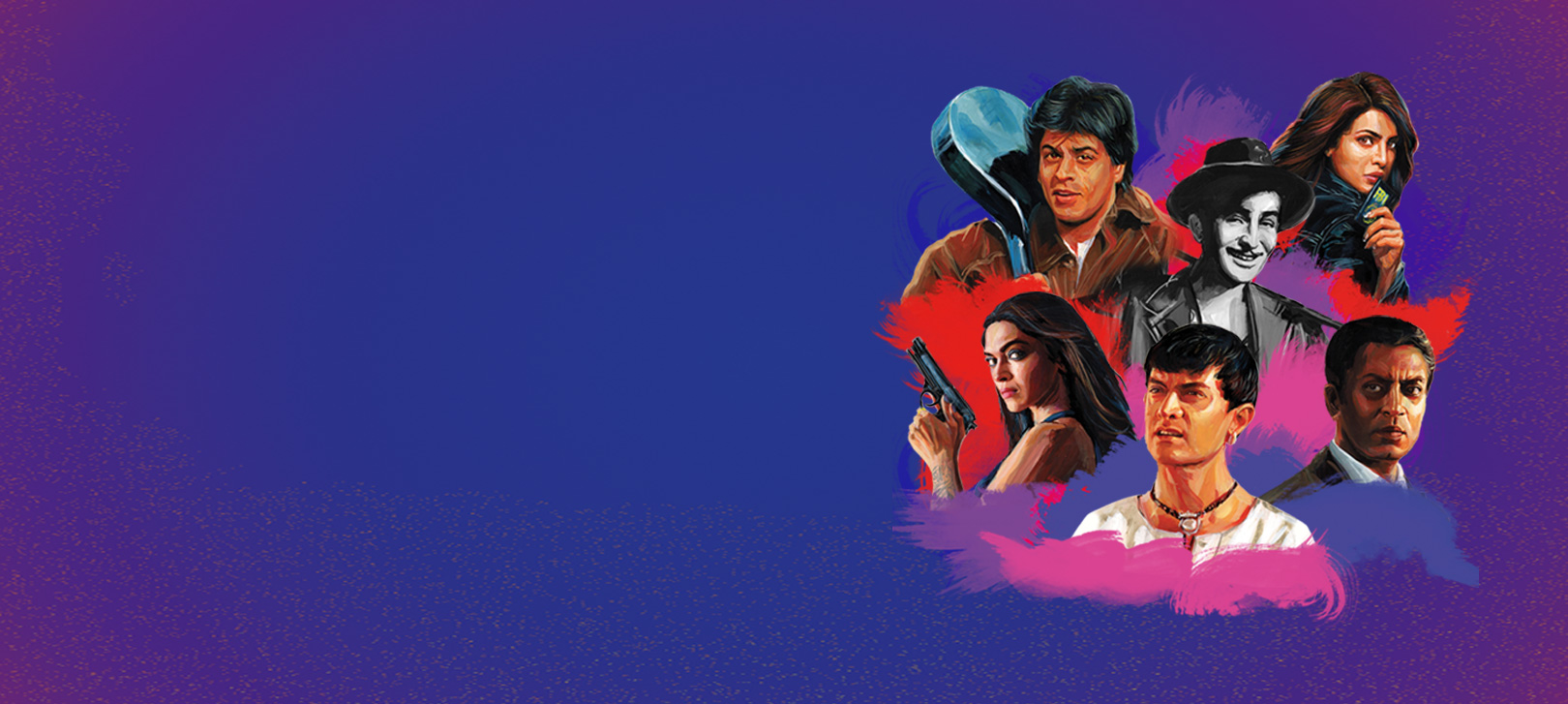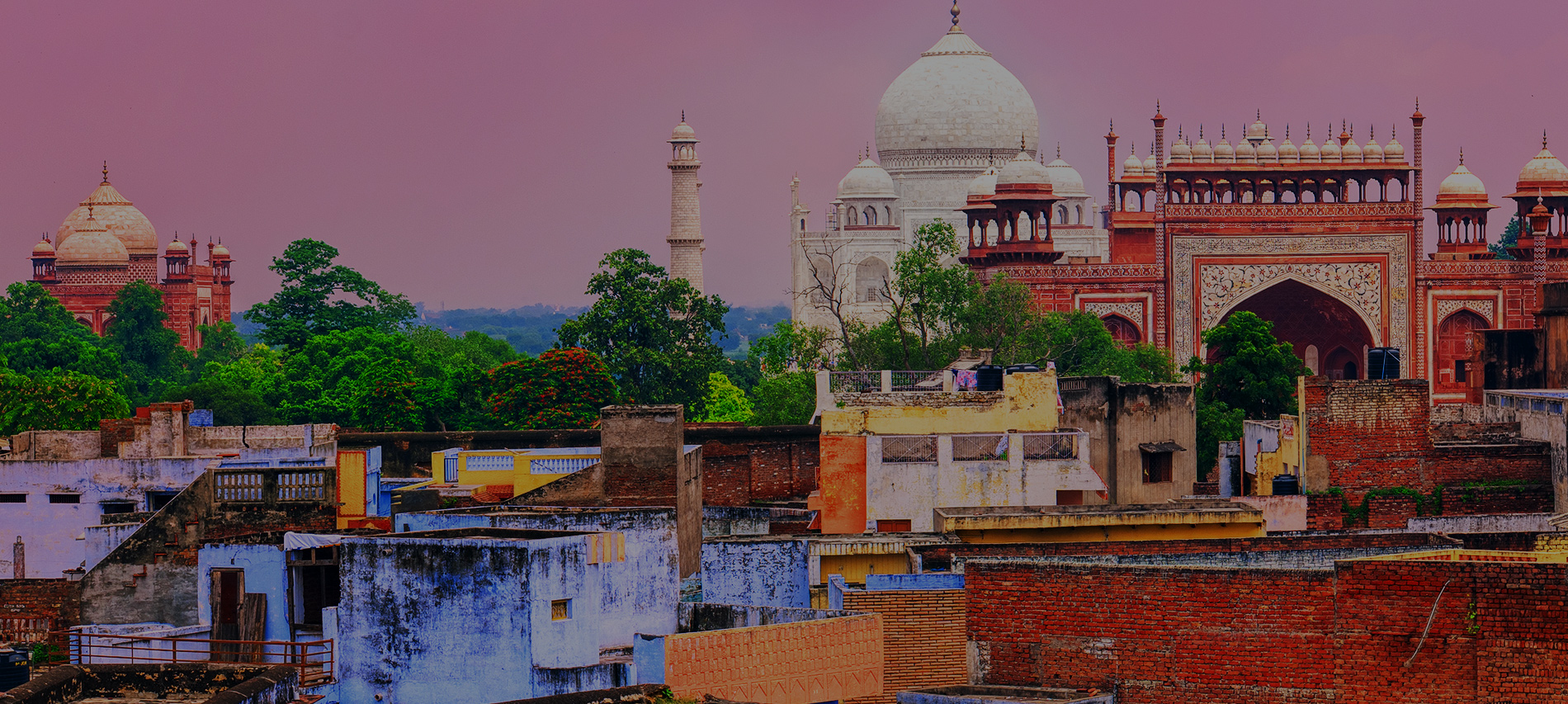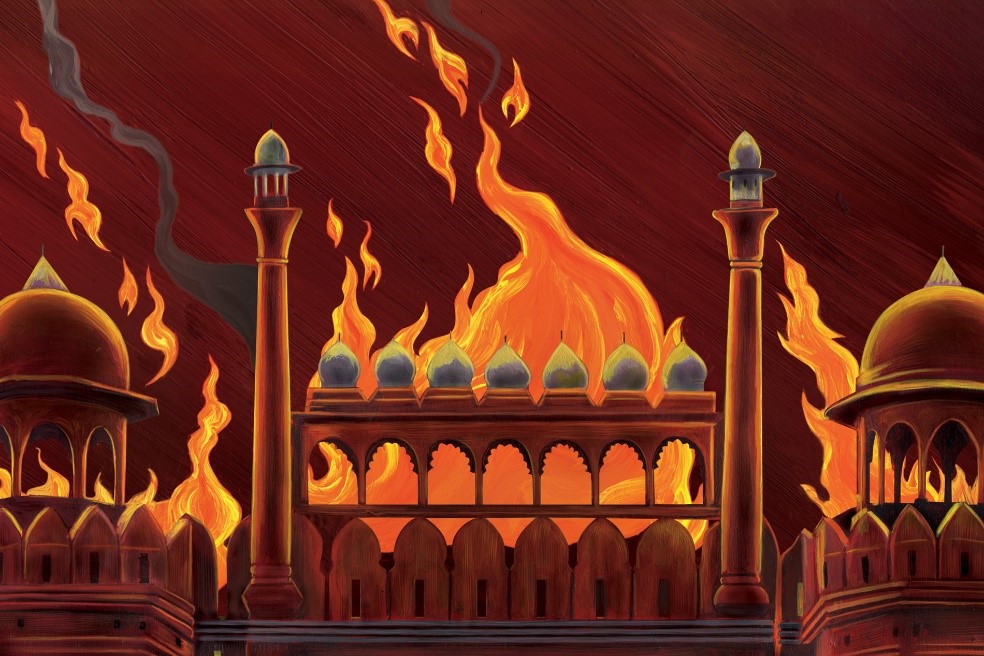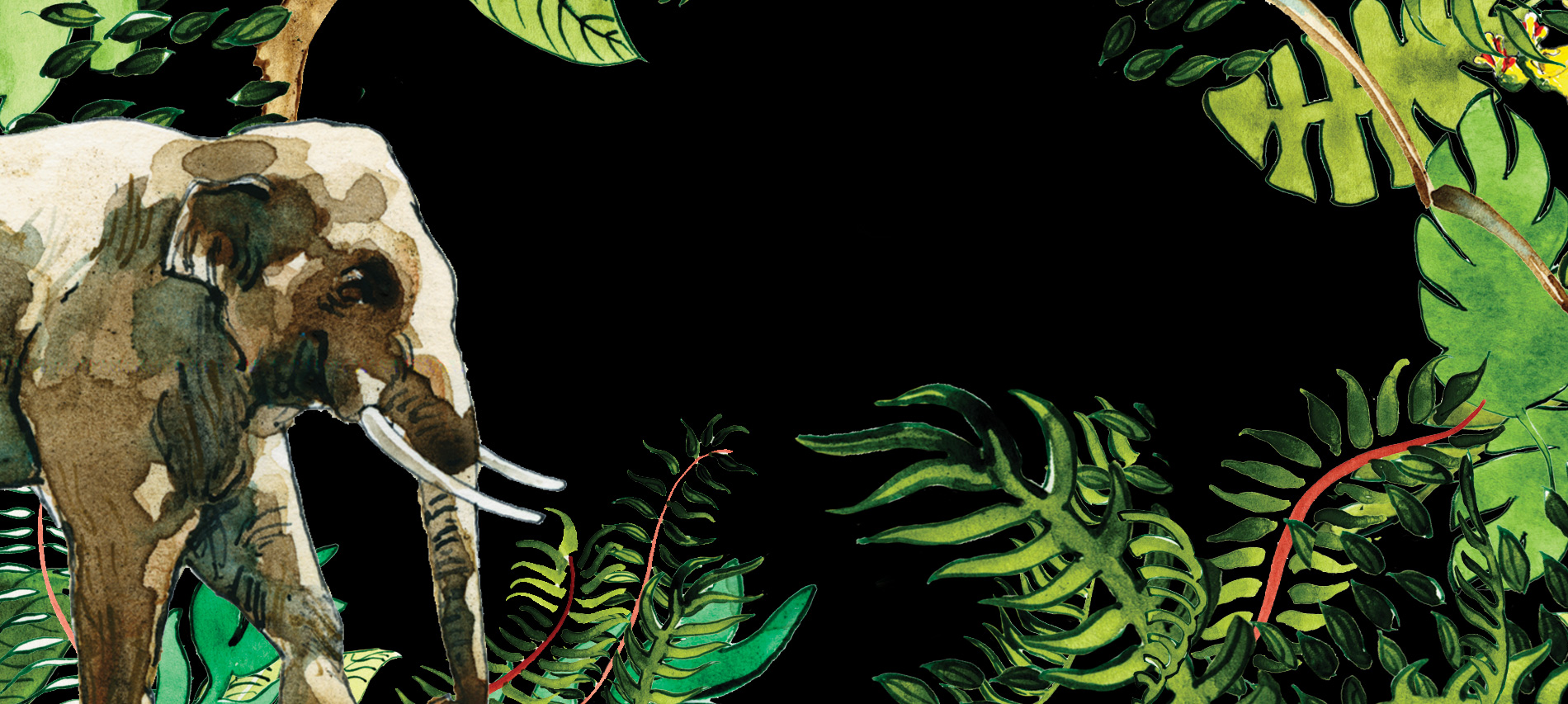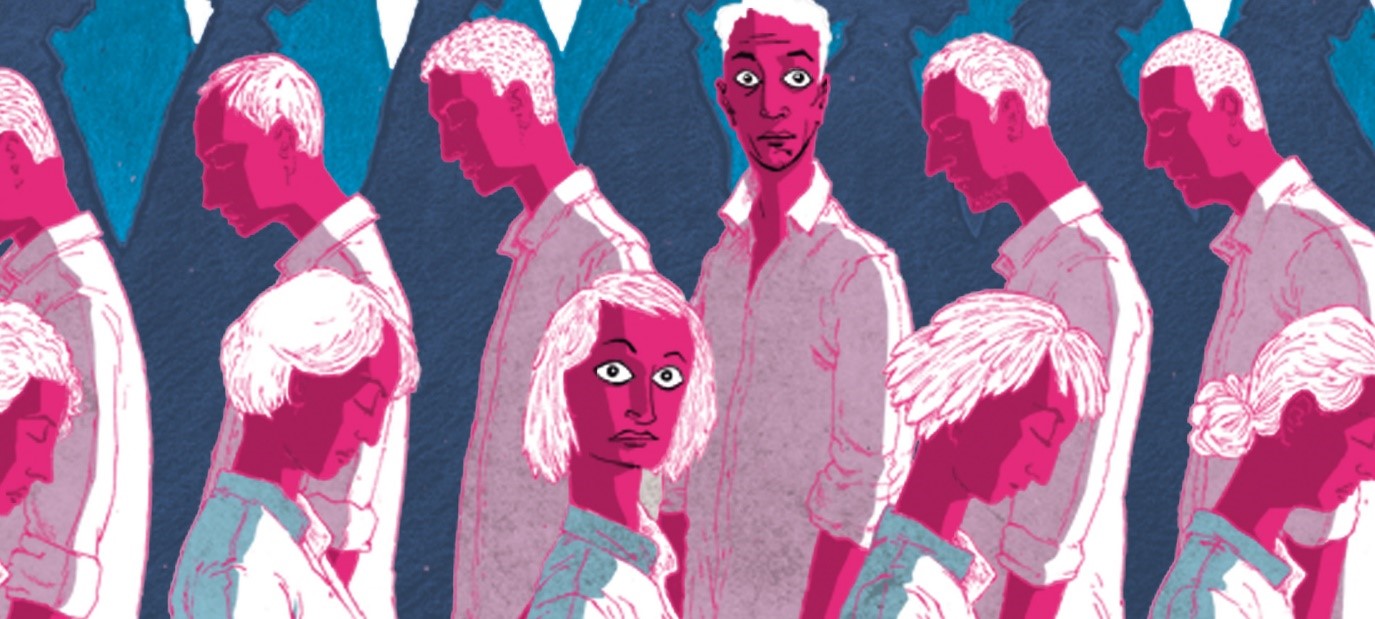When you look at a puja thali, it has many colours. There’s haldi, kumkum (sindoor), abeer which is black, but ‘abeer’ also means red. There’s a white powder and gulal (pink).
Colours are important. It’s almost as if we are playing Holi with the gods. The colours in a puja thali are to excite various sense organs (indriyaan). Fragrant things for smell (like, chandan), different colours for the eyes, a bell for sound, prasad for taste, a lamp and its glowing light (deep) for touch.
If you ever wondered the significance of all the things that go into a puja thali, here are the reasons – from India’s bestselling mythologist, Devdutt Pattanaik.
Haldi
In earlier times, women used to bathe with turmeric to give their skin a golden glow. In Puri temple, Krishna’s sister Subhadra has a yellow face and is called Haldi-mukhi (haldi-faced).

Kumkum
Red kumkum is associated with female gods and you’ll find it mostly in temples of the Devi.

Chandan
After you apply Chandan paste, you have to patiently wait for a while before its colour starts showing. Its fragrance is released immediately. This is a symbol of karma. Once you work, you will get the fruit of your labour.

Bhasm
Anything you burn is reduced to bhasm (ashes). You don’t have to work for it. Finally, you’ll be turned to ash. Shiva, who is a bairagi (an ascetic), smears it all over his body.

Rice
Haldi-kumkum-rice together probably conveys that to grow anything you need two things.

What are the other important things that go in your puja thali? What is their significance? We’d love to know!

Tag: Bulletin Board
6 Myths Around India that Bollywood Has Debunked or Upheld
From Raj Kapoor to Amitabh Bachchan to Shah Rukh Khan, Bollywood has been India’s best cultural ambassador all over the world. In her remarkable new book – Bollywood Boom – Roopa Swaminathan shows how Bollywood has the power to mould India’s fortunes by winning the hearts of people across continents.
Amidst its rising power to influence the world, Bollywood has both debunked and upheld few myths that surround India and Indians. Here’s a look at six of those popular myths!
Myth 1

When lead characters in mainstream Bollywood films were supposed to have sex onscreen, the scenes showed the rubbing together of two flowers or cutaway shots of birds chirping. But Bollywood has come a long way since! It’s a case of building up an already popular myth – that Indians don’t do sex, or they do it mysteriously – and then busting it some decades down the line.
Myth 2

That’s one of the myths that Bollywood has busted in recent times. Indian girls do choose how their lives play out and that is well-represented by a plethora of modern characters in Hindi cinema. The female protagonist in Love Aaj Kal makes a mistake, gets married to the wrong guy but has the guts to break it off and walk into the sunset with the right guy at the end.
Myth 3

When it comes to sex, Indians have increasingly started to explore and choose. The sentiment is reflected in this new era of Bollywood. In Ek Main aur Ek Tu, the female protagonist openly claimed to have slept with more than a few guys.
Myth 4

Either your parents’ house or your home after marriage – apparently, those are the only options that two consenting adults in a romantic relationship can manage. That myth has been debunked! Salaam Namaste deals with the pros and cons of ‘living together’ before getting married
Myth 5

Gone are the days when the international community viewed India only as this mystical land, full of old-world charms. New Bollywood movies show India in its full range now. Much of the diaspora who travel to India do so after being fascinated by an India that they’ve seen in Bollywood films.
Myth 6

Not every Bollywood film is laden with songs and dances. And certainly, not every aspect of Indian life is a high-volume drama. Increasingly, the new wave of Bollywood has brought to the fore other sensibilities of the Indian culture.
Do you, too, have a myth in mind that you think Bollywood has busted or upheld? We would love to know!

3 Times Perumal Murugan Showed Us How Different Yet Similar Cities and Villages are
Celebrated Tamil scholar and writer, Perumal Murugan, was born in a family of farmers.. Murugan’s Current Show and Seasons of the Palm, translated to English from the Tamil originals, are set against the backdrops of a city and a village respectively. Drawing from his personal experiences, the writer draws striking contrasts between life in a city and life in the countryside.
Here are 3 times Perumal Murugan showed us how cities and villages are nothing but the two sides of the same coin.
When he showed us how different the experience of going to the theatre is in a city and a village.


When he showed us how shops in a city were not the same as shops in a village.


When his stories showed us the contrast in how the divine is evoked in the inhabitants of a city and a village.


As Murugan takes us through the concrete jungles of the city and the dusty lanes of the village, tell us how you’ve experience the rural and urban differently.
5 Most Memorable Faiz Ahmed Faiz Shayaris to make your day poetic
Faiz Ahmed Faiz is widely regarded as one of the great Urdu poets of the twentieth century, and the iconic voice of a generation. Although he is best remembered for his revolutionary verses that decried tyranny and called for justice, his oeuvre also extended to scintillating, soulful poems of love.
In The Colours of My Heart – a translation of Faiz’s selected, most memorable poems and ghazals by Baran Farooqi – readers will be able to experience a new dimension of the great poet’s genius. Here are five gems that display Faiz’s extraordinary flair for tender hope and quiet longing.
Beloved, Don’t Ask Me For the Love that Was – “Mujhse Pehli Si Muhabbat Mehboob Na Maang”

Don’t ask me to love you the way I did before, my love
I’d imagined life to be bright and glowing because you were in it
What cared I for sorrows other than the joys of pining in your love?
It’s your beauty that keeps springtime intact upon the world
What else remains to be sought in the universe but your eyes?
Speak – “Bol”

Speak, for your lips are free
Speak, for your tongue is still yours
Your upright body belongs to you
Speak, for your soul still is yours
Highway – “Shahraah”

A long, desolate highway
Its gaze fixed on the far horizon
Spreading out its grey beauty
On the breast of the cold earth—
Like a grief-stricken woman
In her desolate home
Dreaming of her absent lover
Lost in thought, each part of her body immersed
in the idea of union.
The Day of Death – “Jis Roz Qaza Aayegi”

Kis tarah aayegi jis roz qaza aayegi
Shaayad iss tarah ki jis taur kabhi awwal-e shab
Be-talab pehle pahal marhamat-e bosa-e lab
Tyranny Giving Lessons in the Fidelity of Love – “Sitam Sikhlaayega Rasm-e Wafa Aise Nahin Hota”

Sitam sikhlaayega rasm-e wafa aise nahin hota
Sanam dikhlaaenge raah-e khuda aise nahin hota
Enthralled by the verses of one of the greatest Urdu poets? Get The Colours of My Heart here!

Demystifying the Revolt that Ignited India’s Freedom Struggle: 6 Important Points from the 1857 Petition
Zahir Dehlvi, an accomplished poet and young official in the court of Bahadur Shah Zafar, lived through the cataclysmic 1857 revolt that changed the course of history, marking the end of Mughal dominion and the instatement of the British Raj. Dehlvi’s memoir, written on his deathbed, chronicles the fading glory of the Mughal court and most importantly, pivots on the violent siege of Shahjahanabad.
Translated into English for the first time, Dehlvi’s memoir is intensely vivid and moving. Here are six defining moments from the petition made to the then Mughal Emperor by rebellious soldiers that demystify the great revolt.
Rebellious soldiers arrive in Delhi to petition Bahadur Shah Zafar

When cartridges misfired

The ‘meat’ of the matter

Shooting religious sensibilities

When an army was treated like outlaws

Meerut, the epicentre of the revolt

Get Zahir Dehlvi’s riveting account of the Revolt of 1857 here!

5 Things Which Give you a Glimpse of Ecological Reality of India
Prerna Singh Bindra is one of India’s leading wildlife conservationist and writer. In her latest book, The Vanishing, she ponders on the crisis that the flora and fauna of India are facing today. She also asks some pertinent questions such as “Is development inimical to ecological security?” Furthermore, she talks about the steps India has taken towards safeguarding its forests and wildlife.
Here are 5 realities which give an insight into the current status of ecology in India.
Many times, environment sacrifices its elements to make way for development.

India despite a 1.3 billion population, harbours over 60 per cent of the world’s remaining wild tigers.

All contained in just over two per cent of the global land mass.

India’s increasingly battered forests still harbour secrets—and species we thought had vanished, or did not even know existed.

India’s people are remarkably accepting of predators in their midst.

Did the facts leave you appalled? Tell us what are you doing to save the environment.

Kafka on Screen: 5 Must-Watch Films Inspired by the Stories of Franz Kafka
Literary legend, Franz Kafka, has left generations of readers astounded with his fantastical stories, a style that has received its own special name – ‘Kafkaesque’. Alienation, existentialism, absurdity, all of it comes together in Kafka’s works to form a heady, surreal cocktail of words and imageries.
Several filmmakers have been inspired by Kafka’s stories, thereby creating some of the most visually stunning and eccentric works of cinema known to the world. Here are five outstanding adaptations of Kafka’s works one must watch:
The Trial (1962)

Based on Franz Kafka’s novel of the same name, this 1962 film by director Orson Welles follows the story of a bureaucrat who is arrested and persecuted for a crime that is neither mentioned to the protagonist nor to the viewer. Not only is the film the filmmaker’s personal favourite, but over the years has also been touted as a cinematic masterpiece by critics.
Franz Kafka’s It’s a Wonderful Life (1993)

Peter Capaldi’s Academy award winning short-film, Franz Kafka’s It’s a Wonderful Life, begins where writer Kafka started his deliciously dark tale of a man’s metamorphosis into an insect — on a piece of paper. The film explores the frustration of a writer confronting a creative block, as interruptions from the world around keep pouring in, only to make him wonder what it is that his protagonist transforms into when he wakes up. A banana? A kangaroo?
Franz Kafka’s A Country Doctor (2007)

Multiple award-winning anime short-film, Koji Yamamura’s Franz Kafka’s A Country Doctor, is an interpretation of Kafka’s short story by the same name. A bizarre chain of events unfolds when a country doctor visits a young patient in the middle of the night. Strange, unearthly horses, distorted houses and people, a young boy who oscillates between death and the will to die, Yamamura’s beautifully dark visuals married to Kafka’s haunting story leaves the audience questioning and wanting more.
The Metamorphosis of Mr. Samsa (1978)

What can be better than to watch your favourite story come alive in animation? The Metamorphosis of Mr. Samsa by Caroline Leaf is an animated short-film, using beach sand on a piece of glass. Fluid, shadowy images capturing the nightmarish nature of the original story, Leaf’s film is a stunning visual rendition of the most renowned work of Franz Kafka.
Watermelon Man (1970)

Melvin Van-Peeble’s classic, Watermelon Man, is based on the premise of Franz Kafka’s Metamorphosis. When ‘white insurance salesman’, Jeff Berger, wakes up to find himself in a black man’s body, (much like Kafka’s Gregor Samsa finds himself in a beetle’s body when he wakes up) all hell breaks loose as he initially tries to scrub off his dark skin in many creative ways. After finally accepting his reality of having transformed into a black man, Berger ironically finds himself in situations which he looked down upon as a man of white descent.
Tell us which ‘Kafkaeqsue’ film is your favourite.
6 Essential Spices from Masterchef Pankaj Bhadouria’s Kitchen
Straight from the kitchen of India’s first Masterchef, Pankaj Bhadouria, here is a glimpse of her book — The Secret’s in the Spice Mix. Now you’re just a teaspoon away from stirring magic in your pan with these 6 spice mixes you must have in your kitchen:
Greek Seasoning

Za’atar

Pizza Seasoning

Barbecue Sauce

Tawa Subzi Masala

Panch Phoron

So, what is the best kept secret in your kitchen? Tell us as we make our way to gastronomic heaven.

Celebrating Cinema: 5 Reasons You Should Know About this Pioneer of New Wave
Adoor Gopalakrishnan, a name synonymous with revolutionising not just Malayalam cinema, but Indian cinema, was born in Kerala’s Travancore on July 3, 1941. Gopalakrishnan is a Padma Shri, Padma Vibhushan awardee, a Dadasaheb Phalke recipient, 16 times winner of the National Award, 17 times winner of the Kerala State Film Awards, a recipient of Legion of Honour by the French government, and many more.
Here are five more things to learn about the contributions made by this pioneer of New Wave to cinema:
Adoor Gopalakrishnan is an alumnus of the Pune Film Institute (now known as the Film and Television Institute of India). He applied for the ‘screenplay writing and direction’ course in the year 1962.

The filmmaker’s growing passion for cinema urged him to start a film society. In the year 1966, the fifth ‘All India Writers’ Conference’ held in Kerala’s Alwaye gave him the perfect opportunity to establish a film society.

Koodiyattam is the oldest living theatre in the world (2000 years old). Gopalakrishnan fought hard to gain access to the inner sanctums of the koothambalam or the premises of Koodiyattam’s performance to ultimately make a three-hour long documentary on this art form.

Adoor Gopalakrishnan has experimented with sound and silence in his films in ways that were unthinkable. Gopalakrishnan writes a separate script for sound, he would record natural sounds from different sources, like the train tracks, chatter of young college goers, the pouring rain to be used in his films.

Adoor Gopalakrishnan is known to include animals and birds as characters in his films. Our friends from the wild are not the ones to be directed and this, Gopalakrishnan treats, as a creative challenge. In his film Elippathayam, rats play an important and parallel role to the protagonist and his family.

Fascinated by the facts? Read more about the legend of cinema in Gautaman Bhaskaran’s Adoor Gopalakrishnan: A Life in Cinema.
6 Themes of George Orwell’s ‘1984’ that We Need to be Mindful of
George Orwell’s dystopian masterpiece, Nineteen Eighty-Four, is perhaps the most pervasively influential book of the twentieth century, and here are a few important themes of the book that we need to be mindful of.
Totalitarianism: Total Control, Pure Power
The Party – the controller of the superstate – “seeks power entirely for its own sake.” As an official admits: “We are not interested in the good of others; we are interested solely in power, pure power.”

Propaganda Machines
A well-organized and effective propaganda machine goes a long way in ensuring total control of the Party over the superstate and its residents. The regulation and dissemination of information involves “tearing human minds to pieces and putting them together again in new shapes of your choosing.”

The Thing Called Love
The totalitarian knows that to rule people he needs to quell all ways of achieving happiness and fulfilment. Therefore, love and sex, two of the most enriching human experiences, are killed and depersonalized.

Liberty and Censorship
The Ministry of Truth works tirelessly and meticulously to modify public archives and rewrite history. As a result, “the past was erased, the erasure was forgotten, the lie became the truth.”

Language: Doublethink and Newspeak
The residents of the superstate are forced to communicate in Newspeak – the government’s invented language. It plays a pertinent role in the Party’s control over the masses.

Technology: All-seeing Telescreens and a Watchful Eye
The Party needs and develops top-notch technology to exercise ruthless control over the residents. Without telescreens, the Thought Police would fail in its objective of surveillance. And, of course, overseeing all of this is Big Brother.

Gripped by the themes above? Are you going to read or reread Nineteen Eighty-Four? Do tell us about other ominous themes of the book that all of us should be mindful of!








